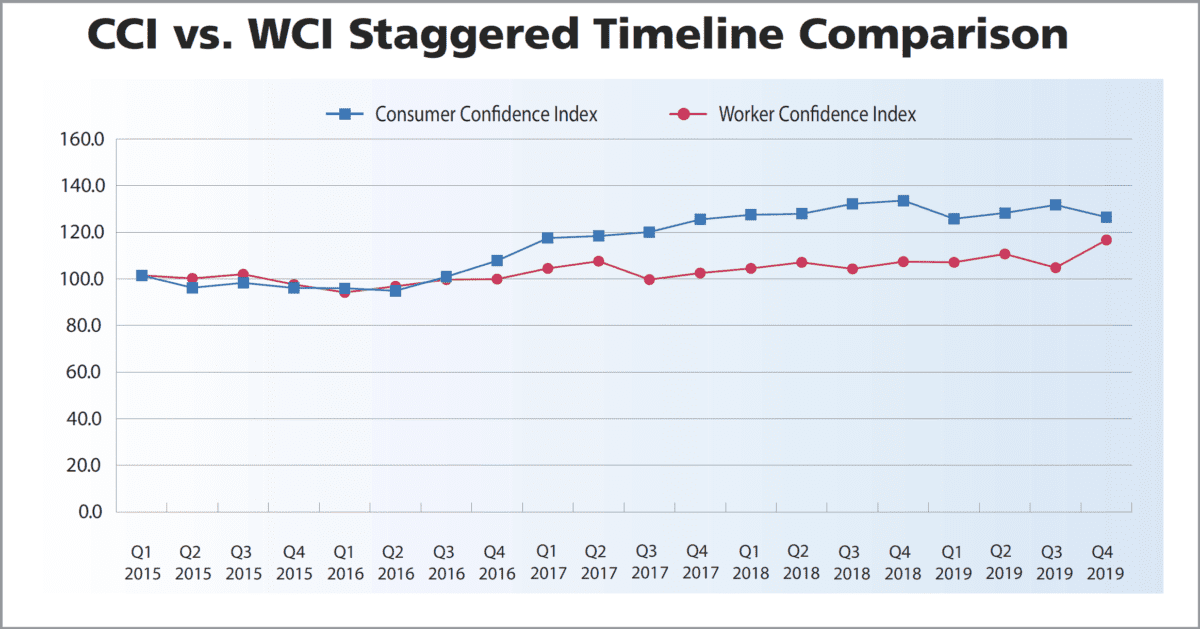2019 finished strong in terms of worker confidence.
By Larry Basinait
At the end of 2019, the Worker Confidence Index (WCI) increased by a robust 7.1 points compared to one year ago. This suggests that workers remain confident with their employment status compared to historical standards, despite a small decline of 2.5 points from the third quarter. For the year, three of the four indices -likelihood of a promotion, likelihood of a raise of at least 3 percent, and trust in company leadership -increased by at least 6 points. The only index to decline was the job security index, down slightly by 2.8 points.
In the fourth quarter of 2019, workers remain secure about job stability, with the job security index increasing by 0.9 points from the third quarter to 102.4, maintaining a high level of confidence throughout the year. Concern about job loss is the most important indicator in estimating worker confidence about current and near-term financial outlook.
Females again reported higher levels of confidence in their job security than males in the fourth quarter of 2019, consistent with the historical norm. According to Pew Research Center, about 20 percent of individuals worry about losing their jobs on a frequent basis, which is lower than other concerns like being able to save for retirement and paying their bills.
Workforce data from the Bureau of Labor Statistics (BLS) remains consistent with positive job security study findings. By the end of the fourth quarter of 2019, the number of people in the U.S. workforce grew by 2 percent from the end of the previous year to a total of 118.5 million. According to the U.S. Census Bureau, the number of males in the workforce increased by 0.9 percent since the third quarter of 2018, while the number of females increased by 1.7 percent from the fourth quarter of last year.
Worker perceptions about the likelihood of a raise increased by 11.7 points for the year to 118.9, despite a slight decrease for the quarter. Males felt more confident about getting a raise, with 39.2 percent anticipating an increase of at least 3 percent at their next review. This is an increase of nearly 4 percent since the fourth quarter of last year. However, females felt less confident in their ability to receive a raise, down 3 percentage points to 26.3 percent. This resulted the largest gap -12.9 percent -between the genders since the inception of the study.
In terms of age, study findings continue to show that as employees get older, anticipation of receiving a raise declines. According to Willis Towers Watson, in 2020, salaries are expected to increase around 3.0 percent for most employees, with 96 percent of companies planning on giving raises to their employees next year.
As optimism about receiving a raise in the upcoming 12 months increased, wages have followed. BLS data shows that seasonally adjusted median weekly earnings were $933 in the fourth quarter of 2019, up a solid 4 percent from one year ago.
While the belief in the likelihood of a promotion index declined in the fourth quarter to 125.6, it remains significantly higher than one year ago (112.7). Both males and females are more optimistic about a promotion than in the fourth quarter of 2018, but males remain much more optimistic than females, with a difference of 8.1 percentage points. Respondents with annual incomes over $100,000 remained the most optimistic (35.5 percent) about the likelihood of a promotion compared with other income groups. This income group has the most disposable income and consumer spending directly impacts the GDP.
The Impact of Market Factors
2019 was a great year for stocks, with all three major U.S. indices increasing by over 20 percent for the year. The Dow Jones Industrials rose 22.3 percent, the S&P 500 increased 28.9 percent, and the Nasdaq Composite rose 35.2 percent. For the S&P 500 and the Nasdaq Composite, this was the largest yearly increase since 2013. The growth of the stock market is likely a contributing reason as to why the WCI has increased over the last year.
The Consumer Confidence Index (CCI) is a widely referenced measure designed to gauge U.S. consumer sentiment about the economy. There was a 5.2 point decrease in fourth quarter of 2019 from the third quarter. The Conference Board states that while the economy hasn’t shown signs of weakening further, there is little to suggest that growth will gain momentum in the short term.
The WCI has correctly predicted the direction of CCI for the next quarter’s end in 15 of the last 20 quarters. An increase in the WCI in the prior quarter would suggest an increase in the CCI at the end of the next quarter. The WCI suggests the CCI will decrease at the conclusion of the first quarter of 2020.















